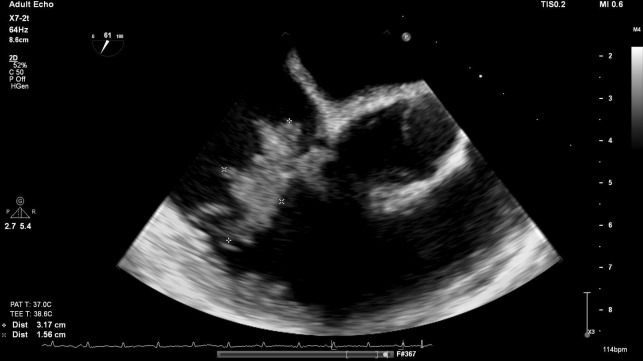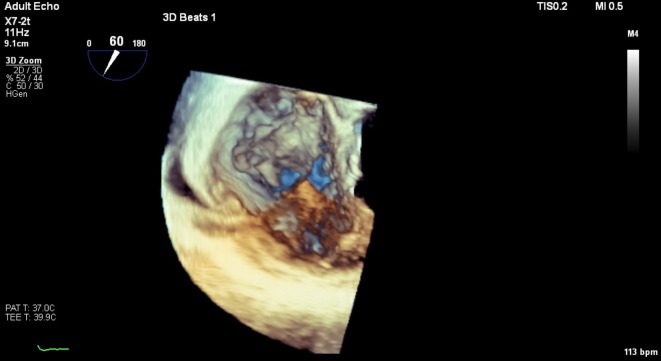Description
A 49-year-old woman, with no relevant medical history and no injectable drug use, was admitted at the hospital after a sudden dyspnoea onset. Pulmonary embolism diagnosis was made on CT angiography. Three months before, she suffered a hand injury with an iron bar smeared with dog faeces. During hospitalisation, she developed a persistent high fever, with four positive aerobic blood cultures to Capnocytophaga canimorsus (growth in BACTEC 9000 MB system and bacterial species identification with matrix-assisted laser desorption/ionisation-time of flight mass spectrometry). Transoesophageal echocardiography revealed tricuspid valve massive destruction, with two large vegetations (the biggest with 32×17 mm; figures 1 and 2, video 1) and severe tricuspid valve regurgitation (video 2) leading to the diagnosis of tricuspid endocarditis (modified Duke criteria fulfilled). Despite targeted antibiotic therapy, based on vegetations dimensions and major risk of continuous embolisation, the patient was successfully submitted to tricuspid valve replacement by the biological prosthesis. Despite the numerous attempts, an antibiotic susceptibility test was not possible to perform. After 6 weeks of meropenem (due to patient penicillin allergy history), she was discharged and remained clinically stable at a 2-month follow-up. Tricuspid valve endocarditis in the absence of intravenous drug abuse, cardiac devices or congenital heart disease is very rare.1 2 The diagnosis requires high indices of suspicion. Fever, multiple pulmonary emboli and sustained bacteraemia can be the signs of right heart endocarditis.1 The fastidious gram-negative bacilli C. canimorsus has been associated with a variety of conditions including septicaemia, meningitis, septic arthritis and rarer infective endocarditis.3–5 There are only 18 cases of C. canimorsus endocarditis reported in the literature since 1977.4 6 7 Moreover, isolated tricuspid endocarditis due to C. canimorsus is an even rarer condition with only four cases published. This is one of the rare cases of isolated tricuspid valve involvement in an immunocompetent patient.
Figure 1.
Echocardiogram showing moderate-to-severe tricuspid valve regurgitation and vegetation of 32 mm in size.
Figure 2.
3D perspective transoesophageal echocardiogram showing the biggest tricuspid vegetation.
Video 1.
Video 2.
Learning points.
Tricuspid valve infectious endocarditis is a very rare condition in immunocompetent patients or in those without any predisposing factors as alcoholism, intravenous drug abuse, cardiac implantable electronic devices, central venous catheters or congenital heart diseases.
The gram-negative bacilli Capnocytophaga canimorsus has been associated with a variety of conditions including septicaemia, meningitis, septic arthritis and rarer endocarditis.
Isolated tricuspid valve endocarditis due to C. canimorsus in immunocompetent patients is an extremely rare condition with few cases described in the last 40 years.
Footnotes
Contributors: RMC is the first author and contributed to the case study and conception of the manuscript. JR and DG contributed to the case study and critical review. IDC supervised the writing critically. All authors have made significant contributions for this manuscript. All authors read and approved the final manuscript.
Competing interests: None declared.
Patient consent for publication: Obtained.
Provenance and peer review: Not commissioned; externally peer reviewed.
References
- 1. Heydari AA, Safari H, Sarvghad MR. Isolated tricuspid valve endocarditis. Int J Infect Dis 2009;13:e109–11. 10.1016/j.ijid.2008.07.018 [DOI] [PubMed] [Google Scholar]
- 2. Deser S, Demirag M. Isolated tricuspid valve infective endocarditis: a rare entity. Med Case Rep 2016;2:1–2. 10.21767/2471-8041.1000035 [DOI] [Google Scholar]
- 3. Ngaage D, Kotidis K, Sandoe J. Do not SNOG the dog: infective endocarditis due to Capnocytophaga canimorsus. Eur J Cardio-thoracic Surg 1999;16:362–3. 10.1016/S1010-7940(99)00131-1 [DOI] [PubMed] [Google Scholar]
- 4. Sakai J, Imanaka K, Kodana M, et al. . Infective endocarditis caused by Capnocytophaga canimorsus; a case report. BMC Infect Dis 2019;19:927 10.1186/s12879-019-4492-3 [DOI] [PMC free article] [PubMed] [Google Scholar]
- 5. Sandoe JAT. Capnocytophaga canimorsus endocarditis. J Med Microbiol 2004;53:245–8. 10.1099/jmm.0.05274-0 [DOI] [PubMed] [Google Scholar]
- 6. Barry M. Double native valve infective endocarditis due to Capnocytophaga canimorsus : First reported case caused by a Lion Bite. Case Rep Infect Dis 2018;2018:1–3. 10.1155/2018/4821939 [DOI] [PMC free article] [PubMed] [Google Scholar]
- 7. Hayani O, Higginson LAJ, Toye B, et al. . Man's best friend? Infective endocarditis due to Capnocytophaga canimorsus. Can J Cardiol 2009;25:e130–2. 10.1016/S0828-282X(09)70076-5 [DOI] [PMC free article] [PubMed] [Google Scholar]




